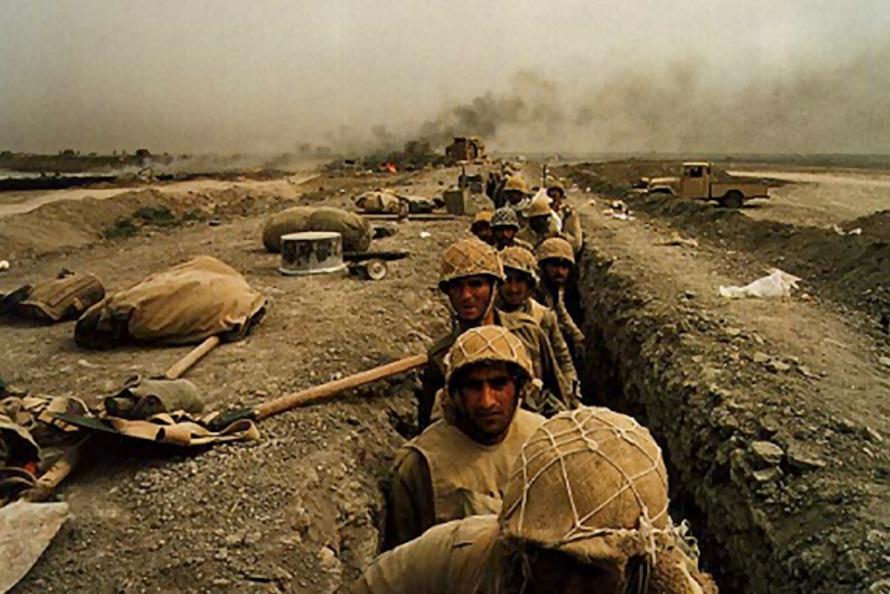
Battlefields of the Iran-Iraq War. Image taken from http://muftah.org/attacking-iran-lessons-from-the-iran-iraq-war/#
During the Iran-Iraq War, which was set off with the Iraqi invasion of Iran in 1980 and which ended in 1988, sectarian ideology was used profusely, both as a tool for propaganda and to help both nations in strengthening their positions. The Sunni versus Shia framework was used as the pretext by Saddam Hussein for Iraq’s invasion of Iran despite his political and geostrategic aspirations. The Shia-Sunni narrative that emerged not only impacted the outcomes of the war, but also led directly to the generation and buffering of the tense sectarian landscape seen manifesting throughout the region today. In order to view the current set of conflicts being fought in Syria, Yemen, and Iraq, it is important to have a comprehensive understanding of the role that sectarianism previously had in mobilizing political, military, and societal forces during the Iran-Iraq War.
While the Iran-Iraq War has been over for nearly three decades, its legacy continues to live on. Not only was this war deemed the longest conventional war of the 20th century, but it exposed and significantly enhanced deep fault lines in a region already inflicted with conflict and animosity, fueling the fires of proxy wars among regional powers. Its legacy is particularly visible upon examination of the the Sunni versus Shia sectarian conflicts that are present in much of the Muslim world, particularly in the greater Middle East.
This rivalry is highlighted primarily through the current cantankerous relationship that exists between Saudi Arabia and Iran that is consequently being played out in modern conflicts in Yemen, Syria, and Iraq. Saudi Arabia has remained the Sunni leader and sought – and continues to seek – to dominate the Islamic world and counter Iran’s growing post-war influence. Concurrently, Iran used and continues to use the knowledge attained during the war in the development of its strategies and policies, including the use of Shia’ism as an instrument of enhancing its power and influence.
Today, similar to the Iran-Iraq War, Shia and Sunni leaders are using these sectarian differences to increase their respective spheres of power, prestige and influence. These divisions have aggravated already existing tensions in the Islamic world since the War. Shia Iran has been supporting Shia groups throughout the region and Saudi Arabia, the dominant Sunni nation, supports Sunni groups. These endeavors are based on opposing strategic interests. Moreover, and again reminiscent of strategies employed during the Iran-Iraq War, sectarianism is an instrument being used by political entrepreneurs to influence behavior, create constituencies and rally popular support. Both countries (Saudi Arabia and Iran) are primarily motivated by politics and competition for influence and power, culminating into the wide scale proxy conflict that has destabilized several countries of the region. As such, sectarian conflict will continue to shape the region into the foreseeable future.
Proxy battles being fought between Iran and Saudi Arabia throughout the region in Iraq, Syria and Yemen are causing these nations to be torn apart by deepening fault lines of Shia versus Sunni and Persian versus Arab forged during the Iran-Iraq War. For example, the current Sunni-Shia divide in Iraq stems from multiple geopolitical, social and cultural transformations, including the establishment of the Islamic Republic of Iran in 1979 and the concurrent rise of the Arab nationalist, Saddam Hussein, in Iraq. These experiences altered the region’s geopolitical landscape, as well as the balance of power in the region. More specifically, the strategic use of sectarian divisions from 1979 onwards, particularly during the Iran-Iraq War created the institutionalization of sectarian identities leading to conflict over status, borders and the power of each community. Thus, having a destabilizing effect and legitimizing conflicts and violent actions that claim to represent their communities.
Iran and Saudi Arabia are using religion to legitimize and by extension facilitate their proxy wars and the resulting bloodshed of countless victims of conflict. By providing support in the form of finances, arms and advisors, they have further exacerbated the volatile situation in the region. In Iraq, for example, there have been approximately 167,192 civilian deaths since the 2003 invasion of Iraq, and in Yemen more than 1,670 civilians were killed in the violence since March 2015. In Syria as of December 7, 2015, approximately 200,000 people have been killed and more than 7.6 million have been displaced.
Just as the legacy of the Iran-Iraq War is one that is plagued with violence, hatred and paranoia, the current sectarian conflict will in all likelihood have the same ripple effect far into the future. The modern Sunni-Shia competition for regional hegemony started with the Iran-Iraq War, in which each side strategically utilized their respective Islamic sect to garner support to enhance their power base. This ultimately put Shia Iran and Sunni Saudi Arabia at odds with one another and created the foundation for ongoing sectarian conflict between the two nations. Sectarianism remains a tool employed to achieve political and geostrategic advantages and ultimately regional dominance. The long-term impact of the sectarian fault lines of the Iran-Iraq War can be seen today across the Muslim world, including in Syria, Iraq and Yemen. These countries have been torn apart by immensely deep divisions and the lives of their citizens have been severely impacted as a result. In other words, the main legacy of the Iran-Iraq War lives on, and the political framework that will eventually emerge will have profound strategic consequences for the region and beyond.
